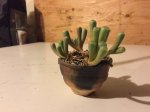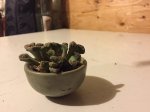Thanks for your detailed response. These little guys are all in pots between 2.5" and 3" wide and 1.5" to 2.5" tall. I think that they are small, humble and "deserty" enough to be used as shitakusa for an arid land tree. The question of seasonality I'm not sure of, as these would most likely be with a tropical or subtropical tree. Anyone else have thoughts?
The answer to season, you need to point to your specific tree to answer the question. For a desert scene, deserts do have seasons, wet season and dry season. If your flat top savanna style acacia has lush new growth, it is rainy season, a succulent in bloom might be a good match. Acacia with no leaves, its dry season, make sure succulent does look dormant. Make sense? This is the reason most keep a number of kusamono around, you can't choose which you will use until you know what the tree will look like in the display.
Similarly, if you have a medium size pine fairly broad spread to branches, put it on a low stand, a bamboo, scroll, the kusamono would probably be a broad leaf miniature, with no flowers, on a flat wood fletch (jita) and you have a summer forest scene. Same tree on a high stand, a mountain theme scroll, accent can be a rock, suiseki, miniature plant grown on a rock, if it has flowers, its spring, or no flowers summer in the mountains.
Same tree, same time of year, Accessories, scroll, stands and kusamono chosen set the time of year.
Its a lot to take in, but as long as you avoid jarring conflicts in image, you can do okay without a lot of study. Key is when you know you are going to display in public, set it up at home, and critically examine it for obvious contradictions, If it passes that test, your display will probably "fit in" at the public display. To have a prize winning display requires thought, creativity and a good size collection of "stuff", that could be used laying around to choose from. I have never won a ribbon for my displays. I have gotten lots of comments about beautiful kusamono,but it didn't match the tree, or the quality of the tree didn't match the kusamono. Etc. Art of display can be taken up as a discipline unto itself, and is beyond my skill set. But it is not hard to make a passable display.



